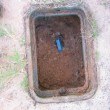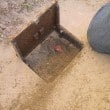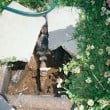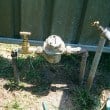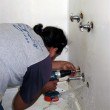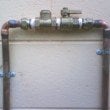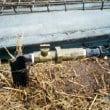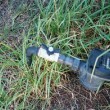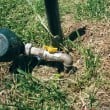B1.7 Turning off water to allow plumbing maintenance
Water isolation valves disconnect each house from the mains water supply to allow for plumbing maintenance. Also known as stop valves or shut off valves, they should allow the simple shutting off of water to the house when changing tap washers, repairing pipes or taps and when there is a major water leak. Specification should consider the type and location of the water isolation valve.
Survey data shows that even teams with the advantage of local knowledge found isolation valves in 81% of the houses surveyed and, of those valves that were found, 60% were working. Time spent by plumbers searching for isolation valves uses scarce housing maintenance funds.
If plumbers cannot find the isolation valve, they will be forced to manage repairs by either shutting off the main water supply to many houses or attempting to do repairs by reducing the water pressure, which involves opening up all taps in the house requiring maintenance. Both these options are unacceptable.
Data also shows that functioning water meters were only found in 55% of surveyed houses, an improvement of 12% since 2013. Regardless of water charges, water management requires basic tools such as isolation valves and water meters to be functioning to allow the housing manager to monitor water use and to assist in completing repairs to the water system of a house.
Design and Specification
Ensure
- B1.7.1.
there is an easily accessed, above ground isolation valve and water meter, for example fixed to a wall of the house, which cannot get ‘lost’ under landscaping or fencing
- B1.7.2.
the pipes to and from the water isolation valve and water meter are protected from physical damage by motor cars and mowers
- B1.7.3.
the type of valve is suited to the water quality.
Consider
- using ball valves, rather than ‘jumper’ or ‘gate’ valves, where water quality is poor
- installing a second valve on houses where the service provider insists on a below ground valve at the property boundary
- selecting water isolation valves that have fixed handles and avoid using anti-vandal valves that do not have a handle
- installing a water meter, regardless of water charging, to assist in water demand management and detecting leaks
- a wall mounted isolation valve above head height.
- if required to be lower for disabled access, then adequately protect the valve to prevent injuries or damage.
Real world examples of Solutions
- B1.7.1.
Quality control
- the type of main water isolation valve specified and that it has been correctly installed

- COMPLETED DESIGN & SPECIFICATION
DURING CONSTRUCTION
AT HANDOVER
FINAL COMPLETION
- COMPLETED DESIGN & SPECIFICATION
- the main water isolation valve is located where specified and is secure

- COMPLETED DESIGN & SPECIFICATION
DURING CONSTRUCTION
AT HANDOVER
FINAL COMPLETION
- COMPLETED DESIGN & SPECIFICATION
- the main water isolation valve can be turned on and off and, if it is a jumper valve or gate valve, turn fully on then back one turn to prevent the valve 'binding' shut in the fully open position

- AT HANDOVER
FINAL COMPLETION
- AT HANDOVER
- that if a main water meter was specified, it has been installed and is working.

- AT HANDOVER
FINAL COMPLETION
- AT HANDOVER
- the type of main water isolation valve specified and that it has been correctly installed
Maintenance
As part of cyclical maintenance:
- check the water isolation valve can be turned off and on and turn jumper or gate valves fully off, then fully on, and then back one turn

- Plumber, Local Maintenance Team
- 12 Months
- when the isolation valve is turned off, all water to the house stops flowing

- Plumber, Local Maintenance Team
- 12 Months
- read the house water meter and record water use and if a house has a high meter reading, ask the plumber to check for leaks.

- Local Maintenance Team, Housing Management
- 3 Months
- check the water isolation valve can be turned off and on and turn jumper or gate valves fully off, then fully on, and then back one turn
Standard And References
AS 4796-2001 : Water supply - Metal bodied and plastic bodied ball valves for property service connection

